| | Late blight is one of the most serious diseases of potatoes and tomatoes worldwide, resulting in significant yield and quality losses annually. In general, in Alberta, Late blight occurs infrequently, but can have devastating impacts in the years when it reaches epidemic levels.
What is the historic and current/potential impact of Late blight
Late blight was responsible, in large part, for the Irish Potato Famine in the 1840’s, which resulted in the death and mass emigration of millions of people. Each year, Late blight reduces the yields of potatoes and tomatoes in the field and can cause major losses in potato tubers in storage.
Late blight is found in most potato and vegetable growing regions of Canada and North America. Major outbreaks occur occasionally in Alberta (the last one was in 1993). Since 2010, there have been reports of Late blight in potatoes and tomatoes in various regions across Alberta, with many urban or residential plantings and market garden crops damaged or destroyed and commercial potato crops also impacted. The commercial potato industry has expended a great deal of effort and cost in applying protective fungicides and maintaining quality seed, with some losses occurring.
Which agricultural industries in Alberta might be affected by Late blight outbreaks?
The commercial seed, processing and table potato industries are at risk from Late blight. Alberta’s potato industry consists of approximately 50,000 acres, with the majority of the crop being grown for processing or seed. Other industries that may also be affected include fresh market garden vegetables (potatoes and tomatoes), greenhouse vegetables (tomatoes, peppers, eggplants), as well as the greenhouse ornamental and garden centre industries (ornamental plants and vegetable transplants). Residential (rural and urban) plantings of potatoes and tomatoes are also impacted and at risk.
What are the host crops for Late blight?
The primary hosts of Late blight are potatoes and tomatoes; however, other related plants can also be affected. These include eggplants, peppers, petunias and Solanaceous weeds, such as nightshade species and wild tomato. While some varieties of these crops are less susceptible than others, NONE is immune.
What causes Late blight?
The fungal pathogen, Phytophthora infestans, is the cause of Late blight. Scientists place this fungus in a group called ‘Oomycetes’, which are water moulds. The pathogen is highly aggressive and can potentially infect all plant parts, causing rapid die back and death. The Late blight organism produces two main spore types, referred to as sporangia and zoospores. Sporangia (singular = sporangium) are formed mainly on infected foliage and are dispersed by wind and water. Multiple zoospores can form within a single sporangium and are able to swim in films of water on the plant and in the soil to infect plant parts.
An overwintering, sexual spore type called an oospore can also be produced by the pathogen if both mating types of the pathogen are present in an area; however, only one mating type presently occurs in Western Canada. Therefore, sexual spores are not known to be produced in Alberta and overwintering is only possible on living host tissues.
The monitoring and testing, it has been found that a number of different strains of the Late blight pathogen occur in any given area in a given year. Each strain differs in its virulence on either potato or tomato host plants. Some strains are more aggressive on tomatoes, while others prefer potatoes. This can affect the types of outbreaks that occur. In recent years, it has been found that Alberta typically has two different strains of Phytophthora, which has resulted in certain hosts being more seriously affected (e.g. tomato crops).
How does this disease spread?
In Western Canada, Late blight does not create the overwintering spore type and requires living tissues to survive to the following season. The pathogen survives between crops on infected seed potatoes, cull potato piles and volunteer potatoes, all of which represent LIVING host tissues.
In season, the disease spreads by spores produced on infected plant material, such as transplants, volunteer potatoes, weeds and diseased crop debris. Sporangia can move between plants within fields by rain or water splashing or short distances in soil, e.g. zoospores wash off foliage and move through the soil in water films to infect tubers. Sporangia can also move long distances, possibly up to 100km, on the wind or in storm fronts. The disease may also be introduced in soil on equipment moving between fields within a short time window.
What are the symptoms of Late blight?
Foliar Symptoms
- Dark, water-soaked lesions (spots) form on leaves, often moving in from leaf tips/margins toward the centre
- Lesions are not contained by leaf veins
- This is distinct from some other common diseases – e.g. Early blight, Alternaria solani
- Young lesions may have a yellow edge or margin
- Within a couple of days, lesions usually turn brown or black in colour and may become brittle if they dry out
- A small amount of spore production (sporangia), which appears as fluffy, white growth on the edges of lesions, may occur at the edges of fresh lesions on the underside of affected leaves
- The disease develops rapidly and a significant proportion of the foliage may die back
- Lesions may also develop on stems, tomato fruit or potato tubers
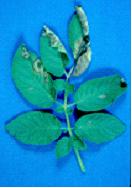 | 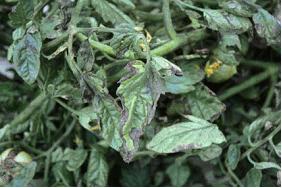 | 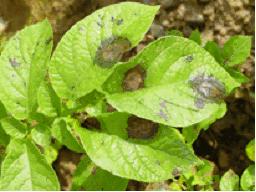 |
Dark, water-soaked lesions develop from leaf tips / margins |
Photos by Dr. Ron Howard | Photo by Dr. Khalil Al-Mughrabi – Govt of NB |
| | |
Lesions may have a yellow edge and are not contained by leaf veins | Spore formation can occur on the edges of lesions on the underside of leaves | Disease development can be rapid; Leaves, stems and entire plants can be infected and foliage may die back rapidly |
Photo by Dr. Ron Howard | Photo by Dr. Khalil Al-Mughrabi – Govt of NB | Photo by Dr. Ron Howard |
|  |  |
Disease can spread rapidly in fields under suitable environmental conditions |  |  |
Photos by Dr. Ron Howard |
Fruit / Tuber Symptoms
- Tomato fruit and potato tubers may have reddish-brown, irregular, sunken lesions, often around the eyes
- The rot can penetrate the skins of fruits and tubers (i.e. 1-2cm), causing rot and discolouration of internal tissues
- Rot is reddish to tan-brown in colour
- Rot is dry and granular unless affected tissues are subsequently invaded by soft rot bacteria
- The line between diseased and healthy tissues is sometimes not clearly defined
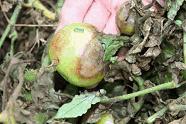 | 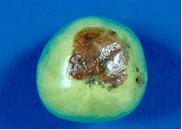 | 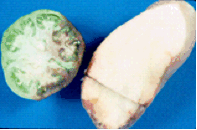 | 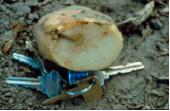 |
Fruit/tuber lesions are reddish-brown, sunken lesions | Rot can penetrate the skin of fruit and tubers (1-2cm), causing rot and discolouration of internal tissues |
Photos by Dr. Ron Howard |
Where can a person obtain assistance with diagnosing Late blight?
It is suggested that digital images and/or samples from industry be directed to qualified industry experts, including government specialists, consulting agrologists, certified crop advisors, or other industry advisors. Home gardeners might consult horticulturists or garden centres, greenhouses, etc. for assistance. Contact government for assistance with the process of diagnosing and managing suspect samples, including where they might be submitted, if possible.
What conditions favour disease development?
The Late blight pathogen develops rapidly under moderate temperatures (12-24°C) and wet/humid conditions, including rain or dew. Overhead / sprinkler irrigation can artificially create these conditions. Spore formation will occur under similar conditions and can occur in as little as 10 hours under ideal conditions. Foliar material is not required for spore production and spread, i.e. sporangia can form on whole tubers or cut seed and be dispersed during handling.
Late blight can spread from infected to healthy fruit and tubers in storage (potato and tomato), as well as in cull piles, undecomposed compost heaps, and seed potato pieces.
What are some of the best steps that I can take to prevent the spread of Late blight?
Be aware of characteristic disease symptoms and rigorously cull out all infected or suspect material (pre and post-season). Do not save infected seed and do not purchase diseased transplants. Where practical, remove infected plant material as soon as it is detected, before the Late blight pathogen can spread to other areas. Ensure that infected material is prevented from continuing to spread spores, either by burying, covering or bagging.
Some sectors (home and market gardens) may find it beneficial to grow Late blight-resistant tomato varieties, to reduce the risk of disease development. Late blight-resistant varieties include Mountain Mist, Defiant PHR, Mountain Merit and Iron Lady.
Greenhouse and garden centre operators might consider growing and offering vegetable transplants of the listed resistant varieties to their clientele, to assist in the reduction of disease in their region.
What effect can infected potato seed have on Late blight development?
Infected tubers represent a significant risk point for introducing Late blight into a planting. Experts agree that there is no such thing as “a little bit of Late blight”. Infected tubers in seed lots or in cull piles can sprout and shoots become infected, thus introducing the disease into an area either directly or through spores dispersed to fields by wind or water.
A one per cent (1%) infection level in seed potatoes can potentially represent 100-150 infected tubers per acre, with a number of infected plants emerging to infect the rest of the field. A 5 per cent (5%) infection level represents 550-725 infected tubers per acre. A single seed potato that emerges infected can potentially infect a 10 foot diameter area of surrounding plants.
What can be done to minimize the impact of infected seed?
Start with clean, healthy seed potatoes and be sure to closely inspect seed and dispose of infected material immediately. Disinfect seed handling (cutting, etc.) equipment often and especially between seed lots.
For commercial producers, apply appropriate seed piece treatments (mancozeb-based) to seed pieces (whole and cut). Treat cut seed immediately after cutting. Seed cutting encourages sporulation (spore production) and opens tubers up to infection. Seed treatments will not make infected seed healthy, but will protect other seed pieces from infection. Do not hold cut seed for long periods of time before planting; rather, it is recommended to cut and plant.
What are some of the general strategies for managing Late blight?
- Avoid introducing Late blight to a planting
- Plant healthy, disease free material (seed potatoes, tomato transplants)
- Do not save seed potatoes from infected plantings
- Grow resistant tomato varieties
- Do not leave diseased plant materials in the open
- Bury, freeze or compost infected plant material
- Place infected material in a plastic bag until it can be frozen
- Cover compost piles with a tarp until pile has frozen or plant material has broken down well
- Control Solanaceous weeds and volunteer potatoes
- Be aware of potential problem areas in plantings, e.g. low areas in garden or field or areas with reduced air flow
- Hill potatoes well to place more of a soil barrier to spores being washed down onto tubers
- Avoid over-fertilization, as this results in heavier tops and poor air flow
- Drip or furrow irrigation can prevent the development of favourable moisture conditions which lead to spore production and disease spread
- Sprinkler irrigation is similar to rain, which wets leaves and can induce sporulation
- Time applications of water so as to reduce the amount of time that leaves remain wet, e.g. avoid early morning or evenings – extends dew period
- Encourage good airflow around plants
- Space plants appropriately
- Orient rows parallel to the direction of prevailing winds, where possible
- Scout for infection early, regularly and thoroughly
- Killing or removing tops stops pathogen growth and can therefore reduce the risk of tuber infection
What are some of the specific management strategies for commercial producers?
- Implement the management strategies listed above, where practical
- Scout fields early and regularly
- Monitor weather conditions and consult disease forecasting systems / reports
- Apply a mancozeb-based seed treatment if there are concerns about seed-borne Late blight
- Do not leave potato cull piles or diseased plant materials in the open
- Bury or freeze infected plant material
- Culled potatoes can be fed to livestock, buried, or composted
- Cover cull or compost piles with a tarp until pile has frozen or plant material has broken down well
- Encourage more rapid breakdown of diseased material, through chopping and incorporating or burial
- Apply protective applications of foliar fungicides (rotating chemistries) at regular intervals when conditions favour disease development
- Be prepared to start spraying early if conditions are present for disease development
- If Late blight is detected in a field or planting, top kill (apply desiccant or physically remove tops) affected plants and a buffer zone of at least double the size of the affected area
- Spot treating infected areas is practical where the disease is detected at an early stage; however, widespread infection may require that large portions or entire fields be top killed to halt disease development and salvage a crop
- Following top killing, apply appropriate protective fungicides to the entire field, including the top killed area
- Tank mixing a protectant fungicide with a top killer, where possible, may save time and reduce application costs
- At the end of the season, allow 2-3 weeks between top killing/plant die down and tuber harvest, to enable plant material to die down and reduce the risk of spore transfer to tubers during harvest
Late Blight Poster 1
Late Blight Poster 2
Late Blight Poster 3
Late Blight of Potato - Canadian Horticulture Council
Prepared by Robert Spencer, Ag-Info Centre, Alberta Agriculture & Rural Development
Contributions by Dr. Ron Howard, Dr. Michele Konschuh and Dr. Michael Harding, Alberta Agriculture & Rural Development; Dr. Khalil Al-Mughrabi, Government of New Brunswick
|
|